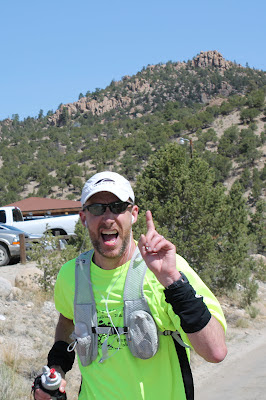Here's a split comparison to last year with the form: mileage/2011 time/2012 time/difference.
02.92 miles/00:26/00:26/-00:00
05.92 miles/01:02/01:01/-00:01
11.57 miles/02:07/02:06/-00:01
14.47 miles/02:37/02:40/+00:03
17.87 miles/03:30/03:25/-00:05
21.70 miles/04:13/04:03/-00:10
24.94 miles/04:53/04:34/-00:19
I had my splits from the previous year memorized and my main goal was to reach the top of the hill by 3:30. From there, I wanted to average low 9 min/miles to the finish. I ended up climbing the hill 8 minutes faster than last year and arrived 5 minutes ahead of my goal. I didn't quite average low 9 min/miles for the rest of the race, but I came damn close. (I blame the energy sucking head wind during the last few miles!) I don't think anyone passed me during the last 7 miles and I managed to reel a bunch of people in. Finishing strong is such a huge psychological boost-- especially when your ultimate goal is to finish a race that 4x as long as the one you're currently racing!
This year's CPTR represents my biggest percentage improvement in a race (6%). It's such a great feeling to see all your training and preparation pay off. A giant grin was plastered on my face for the rest of the day.
 |
| PR! |
A collection of random race thoughts:
- I ate a little over 900 calories during the race (plus 200 calories at the starting line, plus 750 calories for breakfast). That's a little over 200 calories/hour during the race-- barely enough. I skimped on calories during the last leg since I had nothing easy left to eat (i.e., gel) and I really wanted to keep moving. From mile 6-18 I almost always had something in my mouth, dissolving between my teeth and cheek. It took me about a hour to eat a single Honey Stinger Waffle! Most of my calories came from a flask of Hammer gel. I also nibbled on a homemade rice/egg/bacon/cashew bar, which was a welcome change from the other sweet foods I was eating. (I highly recommend The Feed Zone Cookbook.)
- In past races, I've normally consumed calories in little "bursts" every 30 minutes, so this race was a little different. I found myself taking lots of smaller bites of food more frequently. I never stopped eating for a significant amount of time-- it was more of a slow, steady drip of calories. I think this worked well for me since I have an incredibly sensitive gag reflex when I'm running.
- A deep cough around the second aid station turned into a bout of nausea that I fought off for approximately 5 minutes. I was sure that I was going to puke, but I managed to keep everything down. I had to walk for almost half a mile though, and I lost some time during that leg-- running it 3 minutes slower than last year. Who gets nauseated only 11.5 miles into a race? I'm special like that.
- I took nothing from the aid stations except water. There really wasn't anything appealing. I expected that and I was carrying all the food I needed.
- After the first aid station (around mile 6) I was almost always feeling slightly hungry. It was never a problem, but it's amazing to me how many calories I seem to have to eat to stave off hunger while running. It probably doesn't help that I'm 6'5" and 185 lbs.
- How much did my new Hoka One One Mafate 2's help? I keep asking myself that question. I've been running in them now for 3 weeks. What can I say? They feel very,very different than the minimalist running shoes I was running in before (New Balance MT110's). Running downhill is certainly much more comfortable. And the key for slower runners like myself at ultra distances is to generally walk the steep uphills while conserving energy to run the downhills/flats. So shoes optimized for downhill performance make sense. Another important piece of advice for ultrarunning is to focus your efforts on improving your low points during a race. In other words, don't worry about running the first 50 miles 10 minutes faster, work on running the second 50 miles 90 minutes faster! The Hoka One Ones seem well designed for that. They still seem gimmicky to me, and I prefer the "romance" of minimalist shoes, but it's hard to argue with results...
- No IT band pain! Hooray! This was a huge boost in confidence. Disciplined stretching, foam rolling, hip strengthening, and knee icing pays off!
Awesome job Andy! That had to feel good to execute a race just how you planned. It looks like you have some nice take-aways that will help with the rest of your season.
ReplyDeleteI'm a big Hoka fan and I think they're a great shoe for guys our size (we have the same height/weight specs). My feet still ache during long races, but they are magic for me on the downhills. I'll be curious to see what you think of them after a spin on a more rocky course. Keep up the great work and I'll see you Quad Rock!
Thanks, Woody!
ReplyDeleteI'd like to think that my success at CPTR was solely due to improved training and planning on my part, but I must grudgingly admit that the bright yellow clown shoes might have played a small part as well.
I'm excited for Quad Rock too! It'll be quite a contrast to CPTR. I know that course very, very well, but I've never run in Fort Collins before. The (anticipated) heat at Quad Rock will be an added bonus! The all time historical high in Leadville is 85F.